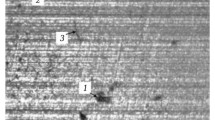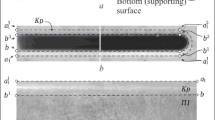An original procedure is used to study the kinetics of surface layer structural changes of a ceramic component surface layer outside the area of contact interaction during operation. The main features of this process are established and the effect the degree of defectiveness of the initial surface layer on changes that occur is revealed.



Similar content being viewed by others
References
V. V. Kuzin, S. N. Grigoriev, and M. A. Volosova, “Change in ceramic object surface layer structure during operation. Part 1,” Novye Ogneupory, No. 2, 39 – 45 (2020).
V. V. Kuzin, S. N. Grigoriev, and M. A. Volosova, “The role of the thermal factor in the wear mechanism of ceramic tools : Part 1. Macrolevel,” Journal of Friction and Wear, 35(6), 505 – 510 (2014).
V. V. Kuzin, S. N. Grigoriev, and M. Yu. Federov “Role of the thermal factor in the wear mechanism of ceramic tools. Part 2. Microlevel,” Journal of Friction and Wear, 36(1), 40 – 44 (2015).
M. A. Volosova and V. V. Kuzin, “Regular features of wear of cutting plates from oxide and nitride ceramics,” Met. Sci. Heat Treat., 54(1/2), 41 – 46 (2012).
V. V. Kuzin, M. A. Volosova, and M. Yu. Fedorov, “Wear of tools from nitride ceramics when machining nickel-based alloys,” Journal of Friction and Wear, 34(3), 199 – 203 (2013).
V. V. Kuzin, V. N. Anikin, S. Yu. Fedorov, et al., “Wear and failure of ceramic cutting plates,” Russian Engineering Research., 30(11), 1116 – 1123 (2010).
V. Kuzin and S. Grigoriev, “Tool life and wear mechanism of coated Si3N4 ceramic tools in turning grey cast iron,” Key Eng. Mater., 581, 14 – 17 (2014).
V. Kuzin, S. Grigoriev, S. Fedorov, et al., “Surface defects formation in grinding of silicon nitride ceramics,” Applied Mechanics and Materials, 752/753, 402 – 406 (2015).
V. V. Kuzin, “Technology for machining high-refractory ceramic parts based on silicon nitride,” Refract. Ind. Ceram., 47(4), 204 – 208 (2006).
V. V. Kuzin, “Technological aspects of diamond grinding of the nitride ceramics,” Russian Engineering Research, 24(1), 23 – 28 (2004).
V. V. Kuzin, S. N. Grigor’ev, and V. N. Anikin, “Introduction to ceramic micromechanics. Ceramic object operating system,” Refract. Ind. Ceram., 60(1), 120 – 123 (2019).
The present work was financed within the scope of a state assignment of the Russian Federation Ministry of Education and Science (project No. FSPS-2020-0025).
Author information
Authors and Affiliations
Corresponding author
Additional information
Translated from Novye Ogneupory, No. 3, pp. 50 – 55, March, 2020.
1Conclusion. Part 1 of the article published in Novye Ogneupory, No. 2 (2020).
Rights and permissions
About this article
Cite this article
Kuzin, V.V., Grigor’ev, S.N. & Volosova, M.A. Change in Ceramic Object Surface Layer Structure During Operation. Part 21. Refract Ind Ceram 61, 178–182 (2020). https://doi.org/10.1007/s11148-020-00451-x
Received:
Published:
Issue Date:
DOI: https://doi.org/10.1007/s11148-020-00451-x




